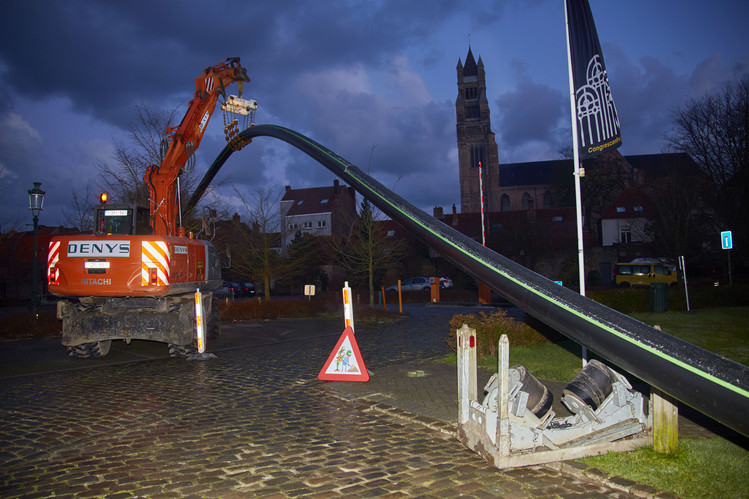
#359
PIPE DREAM
09 May 2016 By David Fuhrmann-Lim
A Belgium brewery is building a pipeline for shipping beer – 1,500 gallons an hour – to its bottling factory in an effort to reduce the need for trucks. The project is expected to finish soon – investors will get a lifetime supply of beer.
BY MATTHIAS VERBERGT
Xavier Vanneste, heir to a dynasty of beer brewers in this medieval city, had a pipe dream.
When he woke up and looked out of his window one spring morning, he saw workers on the street laying underground utility cables in front of his house, situated on the same ancient square as the brewery he runs.
“I immediately realized this was the solution,” Mr. Vanneste said.
The brewery’s truck fleet had been bottling up the city’s narrow, cobblestone streets. Matters had been getting worse since 2010, when the brewery moved its bottling facility out of town.
His brain wave? A beer pipeline.
“It all started as a joke,” said Mr. Vanneste. “Nobody believed it was going to work.”
Four years later, the pipeline is just weeks away from completion. It stretches 2 miles from the brewery, De Halve Maan, or The Half Moon, in the city center to the bottling plant in an industrial area. It will be able to carry 1,500 gallons of beer an hour at 12 mph. Hundreds of truck trips a year will no longer be necessary.
Not long after the project was announced, the burghers of Bruges started dreaming of siphoning off personal supplies.
A local satirical TV show tricked people living near the route into believing that beer taps could be installed in their houses. Mr. Vanneste said it would be impossible to illegally tap into the polyethylene tubes, which he said are stronger than steel.
The citywide attention gave Mr. Vanneste another idea. He’d partly fund the €4 million ($4.5 million) investment by offering lifetime supplies of beer. Attracted by the liquid returns, brew-lovers sank some €300,000 into the project.
They were offered three options. The most expensive “gold” membership, which costs €7,500, entitles the holder to an 11-ounce bottle of Brugse Zot beer (retail price, €1.70) every day for life, along with 18 personalized glasses.
One of the 21 people who signed up for that was Philippe Le Loup, who runs a restaurant on the scenic Simon Stevin square, a few hundred yards from the pipeline. Mr. Le Loup, whose establishment serves about 1,850 gallons of Brugse Zot a year, said he would have preferred a direct tap into the pipeline. “It would have saved me a lot of keg-dragging,” he said.

De Halve Maan brewery is running a pipeline for beer under the streets of Bruges, Belgium. Photo: Mahaux
Mr. Le Loup also bought bronze memberships, at €220 apiece, for each of his 12 employees, entitling them to a 25-ounce bottle of beer every year for life. “In total, I invested over €10,000,” said Mr. Le Loup, 35 years old, who was born in the city. “I calculated that if I pick up my free beers for 15 years, my investment will be paid back.” He said he plans to drink most of the beer himself.
“When I’m 50, I will make profit,” he said.
Last year, De Halve Maan exported about 200,000 liters of its most popular beers, Brugse Zot and Straffe Hendrik, to the U.S., double the 2014 figure.
Ronald Martin, a music teacher, home brewer and De Halve Maan fan in Buffalo, N.Y., was one of 76 foreigners to pitch in.
When he visited Bruges, he was convinced the pipeline was happening. He wanted to be the first American to take part. “When I walked into the brewery, the secretary had a phone call from another American,” Mr. Martin recalled. He immediately went to get cash and signed up.
“When you talk about a beer pipeline, everyone thinks you’re joking,” he said. “But it’s a serious thing.”
A few European sports arenas have aboveground pipelines. In Randers, Denmark, a pipeline under a street carries beer to some bars. The annual Oktoberfest beer festival in Munich, Germany, pipes beer to some tents. In Cleveland, Ohio, the Great Lakes Brewing Company moves beer through a pipe from its brewery to a bar across the street.
The city of Bruges, which last year attracted 6.6 million tourists, has long been looking for solutions to reduce traffic in its historic center—a Unesco World Heritage site known for its canals and medieval architecture.
“The pipeline is a breakthrough,” said Renaat Landuyt, mayor of Bruges, which was the economic capital of Northern Europe between 1200 and 1400.
Mr. Landuyt said he would even consider constructing pipelines for other goods, including chocolate, one of Belgium’s other precious commodities. “Everyone who proposes alternative means of transport is welcome here,” he said.
The centuries-old brewing company, the last one remaining in the city center, said its new pipeline wouldn’t affect the taste of its award-winning beers.
Most of the pipe runs about 6 feet underground, but in some spots it goes about 100 feet under. On a recent day, workers were digging holes, connecting tubes and replacing cobblestones on Zonnekemeers, a street near De Halve Maan, attracting the attention of many bystanders.
“The beer pipeline has become a sight,” said Alain De Pré, who oversees the construction of the pipeline. “People are taking more pictures of this than of the monuments around us.”
Sylvie Melkenbeek, a 78-year-old retiree, was enjoying her espresso on a sunlit terrace in front of De Halve Maan as horse carriages rolled by carrying tourists. Ms. Melkenbeek, whose last name literally translates as “stream of milk,” said she would much prefer a pipeline filled with coffee.
“I don’t like beer,” she said.
Read it at WSJ
Like this? Read about the 500th anniversary of the Reinheitsgebot

You might be interested in...
FRANCE DETHRONES BELGIUM
The French have done it again. They gave their opinion, and got awarded for it.
FRANCE DETHRONES BELGIUM